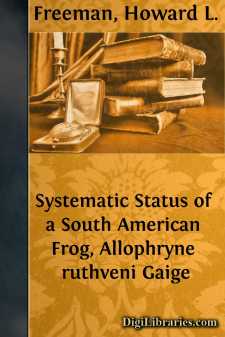Categories
- Antiques & Collectibles 13
- Architecture 36
- Art 48
- Bibles 22
- Biography & Autobiography 813
- Body, Mind & Spirit 142
- Business & Economics 28
- Children's Books 15
- Children's Fiction 12
- Computers 4
- Cooking 94
- Crafts & Hobbies 4
- Drama 346
- Education 46
- Family & Relationships 57
- Fiction 11828
- Games 19
- Gardening 17
- Health & Fitness 34
- History 1377
- House & Home 1
- Humor 147
- Juvenile Fiction 1873
- Juvenile Nonfiction 202
- Language Arts & Disciplines 88
- Law 16
- Literary Collections 686
- Literary Criticism 179
- Mathematics 13
- Medical 41
- Music 40
- Nature 179
- Non-Classifiable 1768
- Performing Arts 7
- Periodicals 1453
- Philosophy 64
- Photography 2
- Poetry 896
- Political Science 203
- Psychology 42
- Reference 154
- Religion 513
- Science 126
- Self-Help 84
- Social Science 81
- Sports & Recreation 34
- Study Aids 3
- Technology & Engineering 59
- Transportation 23
- Travel 463
- True Crime 29
Systematic Status of a South American Frog, Allophryne ruthveni Gaige
Description:
Excerpt
Gaige (1926) described Allophryne ruthveni as a new genus and species of diminutive bufonid from British Guiana. Noble (1931) considered A. ruthveni to be a toothless relative of Centrolenella and placed the genus in the Hylidae. Gallardo (1965) suggested that Allophryne is a leptodactylid of uncertain affinities. Other references to the monotypic genus have consisted only of a listing of the name or of its inclusion in a key. To date the holotype and one paratype (both females) have been reported (Gaige, 1926), and the family position of the genus remains unsettled.
A male of Allophryne ruthveni is among the amphibians and reptiles collected in southern British Guiana by William A. Bentley in January, 1962, and deposited in the Museum of Natural History at The University of Kansas (KU). Four additional specimens (females) are in the American Museum of Natural History; only one of the latter has definite locality data.
Acknowledgments.—We are grateful to Dr. Ernest E. Williams, Museum of Comparative Zoology (MCZ) and Dr. Richard G. Zweifel, American Museum of Natural History (AMNH) for the loan of specimens. We are further indebted to Dr. Zweifel for permission to clear and stain one specimen. Dr. William E. Duellman and Linda Trueb offered many constructive criticisms. Miss Trueb executed the drawings of the skull and finger bones. Mr. Martin Wiley provided x-ray photographs of Allophryne.
METHODS AND MATERIALS
Six of the seven known specimens were available for study. Measurements were taken in the manner described by Duellman (1956). One specimen was cleared and stained, using the technique of Davis and Gore (1936), in order to study the skeleton. X-ray photographs were made of another specimen for comparison.
Specimens examined.—Six, as follows: BRITISH GUIANA, Dist. Demarara: Marudi Creek, AMNH 44749; Dist. Equibo: Tumatumari, MCZ 11790 (paratype); Dist. Rupununi (Berbice): Wai Wai Country, N of Acarahy Mountains, west of New River (2°N, 58°W), KU 69890. Also, 3 specimens from "probably British Guiana," AMNH 70108-10 (70110 cleared and stained).
The availability of additional material and the new information pertaining to osteology permit an amplification of Gaige's (1926) description.
Genus Allophryne Gaige
Allophryne Gaige, Occas. Papers Mus. Zool., Univ. Michigan, 176:1, Oct. 14, 1926. Crawford, Annals Carnegie Mus., 21(1):29, 32, Nov. 14, 1931. Noble, The biology of the amphibia. McGraw-Hill, p. 510, 1931. Ruthven, Herpetologica, 1:3, July 11, 1936. Gallardo, Papéis Avulsos, 17:79, Jan. 1, 1965.
Type species.—Allophryne ruthveni Gaige.
Diagnosis and definition.—A genus of diminutive frogs; vomers, maxillae, and premaxillae edentate; skin of head strongly anchored to connective tissue on cranium; prepollical spine absent in males; disk of third finger larger than tympanum, smaller than eye; no humeral hook in either sex; ilia extending anteriorly beyond sacral expansions; adults attaining snout-vent length of 31 mm.; male having darkened external subgular vocal sac; skin of dorsum pustulate.
Allophryne ruthveni Gaige
Allophryne ruthveni Gaige, Occas. Papers Mus. Zool., Univ. Michigan, 176:1-3, pl. I, Oct. 14, 1926. Crawford, Annals Carnegie Mus., 21(1):32, Nov. 14, 1931. Ruthven, Herpetologica, 1:3, July 11, 1936. Barbour and Loveridge, Bull. Mus. Comp. Zool., 96(2):64, Feb., 1946. Peters, Occas. Papers Mus. Zool., Univ. Michigan, 539:10, Sept. 19, 1952.
Holotype.—University of Michigan Museum of Zoology 63419, adult female, from Tukeit Hill, below Kaiteur Falls, Equibo District, British Guiana; obtained in May, 1924, by E....


